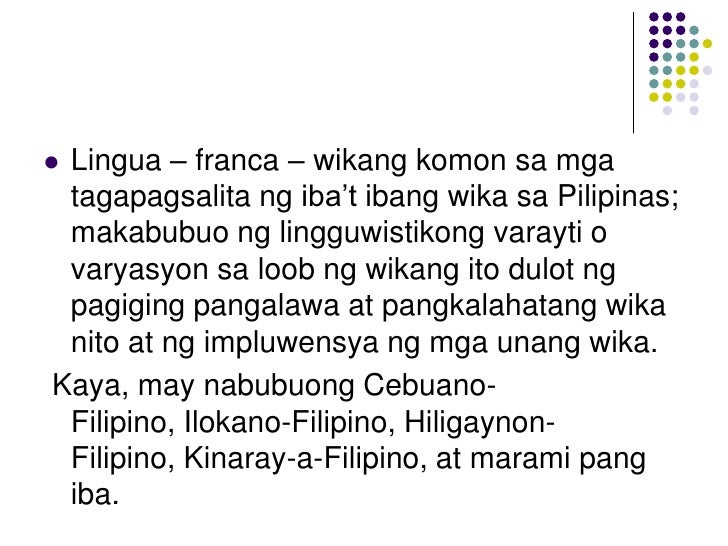Pdf Mga Wika At Dayalekto Sa Pilipinas Ni
Countries where it is spoken by minor communities Tagalog (; Tagalog pronunciation: ) is an spoken as a first language by a quarter of the population of the and as a second language by the majority. Its standardized form, named, is the of the Philippines, and is one of two official languages alongside. It is related to other, such as the,, the,, and, and more distantly to other Austronesian languages, such as the of, ( and ),,,. Tagalog is the predominant language used in the, a type of Filipino poem and the indigenous poetic art of the Tagalog people.
This section needs expansion. You can help. ( March 2018) Upon the issuance of Executive Order No. 134, Tagalog was declared as basis of the National Language.
On 12th of April 1940, Executive No. 263 was issued ordering the teaching of the national language in all public and private schools in the country. Article XIV, Section 7 of the 1987 specifies, in part: Subject to provisions of law and as the Congress may deem appropriate, the Government shall take steps to initiate and sustain the use of Filipino as a medium of official communication and as language of instruction in the educational system. The regional languages are the auxiliary official languages in the regions and shall serve as auxiliary media of instruction therein.
Anong wika ang pinagbatayan ng bawat dayalekto? Pagproseso sa kasagutan sa mga tanong B. Ng Pagkakaiba-iba ng mga Wika sa.
In 2009, the promulgated an order institutionalizing a system of mother-tongue based multilingual education ('MLE'), wherein instruction is conducted primarily in a student's mother tongue (one of the various regional Philippine languages) until at least grade three, with additional languages such as Filipino and English being introduced as separate subjects no earlier than grade two. In secondary school, Filipino and English become the primary languages of instruction, with the learner's first language taking on an auxiliary role. After pilot tests in selected schools, the MLE program was implemented nationwide from School Year (SY) 2012-2013. It is the first language of a quarter of the population of the (particularly in Central and Southern Luzon) and a second language of the majority.
Classification [ ] Tagalog is a language within the language family. Being, it is related to other Austronesian languages, such as,, ( and ), (of Timor), and (of Taiwan). It is closely related to the languages spoken in the and the islands, such as the and the, including,.
Dialects [ ]. Main article: Taglish and Englog are names given to a mix of English and Tagalog. The amount of English vs. Tagalog varies from the occasional use of English loan words to changing language in mid-sentence. Such code-switching is prevalent throughout the Philippines and in various languages of the Philippines other than Tagalog. Code-mixing also entails the use of foreign words that are 'Filipinized' by reforming them using Filipino rules, such as verb conjugations.
Users typically use Filipino or English words, whichever comes to mind first or whichever is easier to use. 'Magshoshopping kami sa mall. Sino ba ang magdadrive sa shopping center?'
Quake 4 pc torrent. 'We will go shopping at the mall. Who will drive to the shopping center?' City-dwellers are more likely to do this. The practice is common in television, radio, and print media as well. Advertisements from companies like,,,, and have contained Taglish.

Phonology [ ]. Main article: Tagalog was written in an —or —called prior to the Spanish colonial period in the Philippines, in the 16th century. This particular was composed of symbols representing three and 14. Belonging to the of scripts, it shares similarities with the script of and is believed to be descended from the script used by the in. Although it enjoyed a relatively high level of literacy, Baybayin gradually fell into disuse in favor of the taught by the Spaniards during their rule.
There has been confusion of how to use Baybayin, which is actually an, or an, rather than an. Not every letter in the Latin alphabet is represented with one of those in the Baybayin alphasyllabary. Rather than letters being put together to make sounds as in Western languages, Baybayin uses symbols to represent syllables. A 'kudlit' resembling an apostrophe is used above or below a symbol to change the vowel sound after its consonant. Determinism and possibilism in geography pdf notes basic computer pdf.
If the kudlit is used above, the vowel is an 'E' or 'I' sound. If the kudlit is used below, the vowel is an 'O' or 'U' sound. A special kudlit was later added by Spanish missionaries in which a cross placed below the symbol to get rid of the vowel sound all together, leaving a consonant.
Previously, the consonant without a following vowel was simply left out (for example, bundok being rendered as budo), forcing the reader to use context when reading such words.